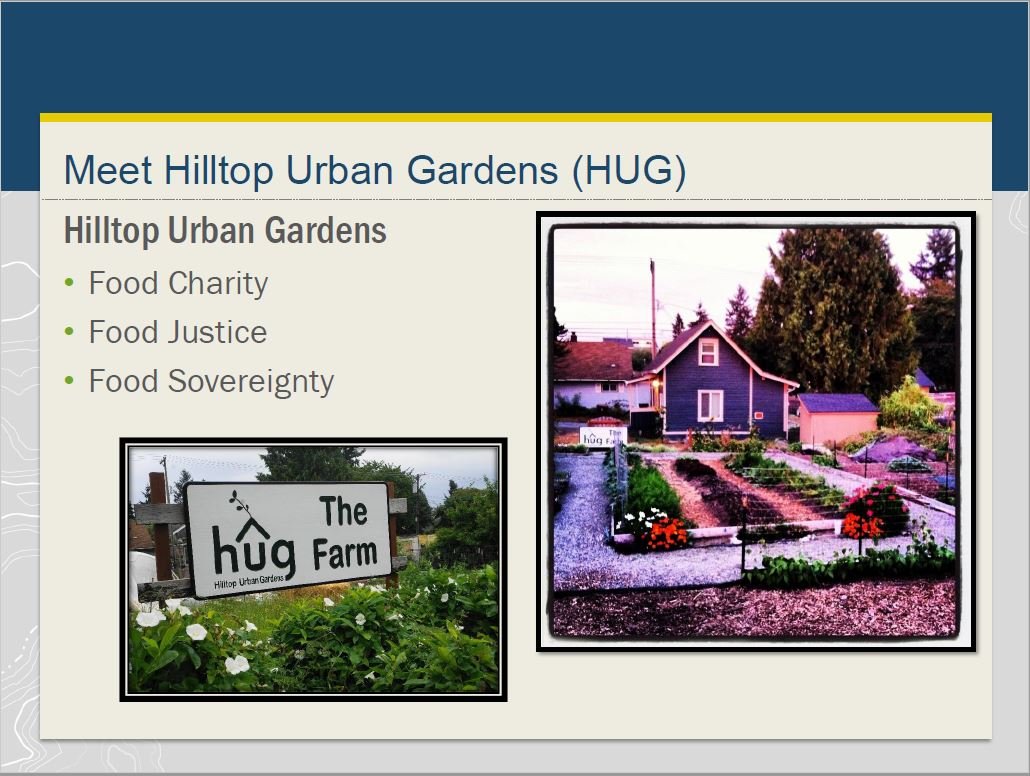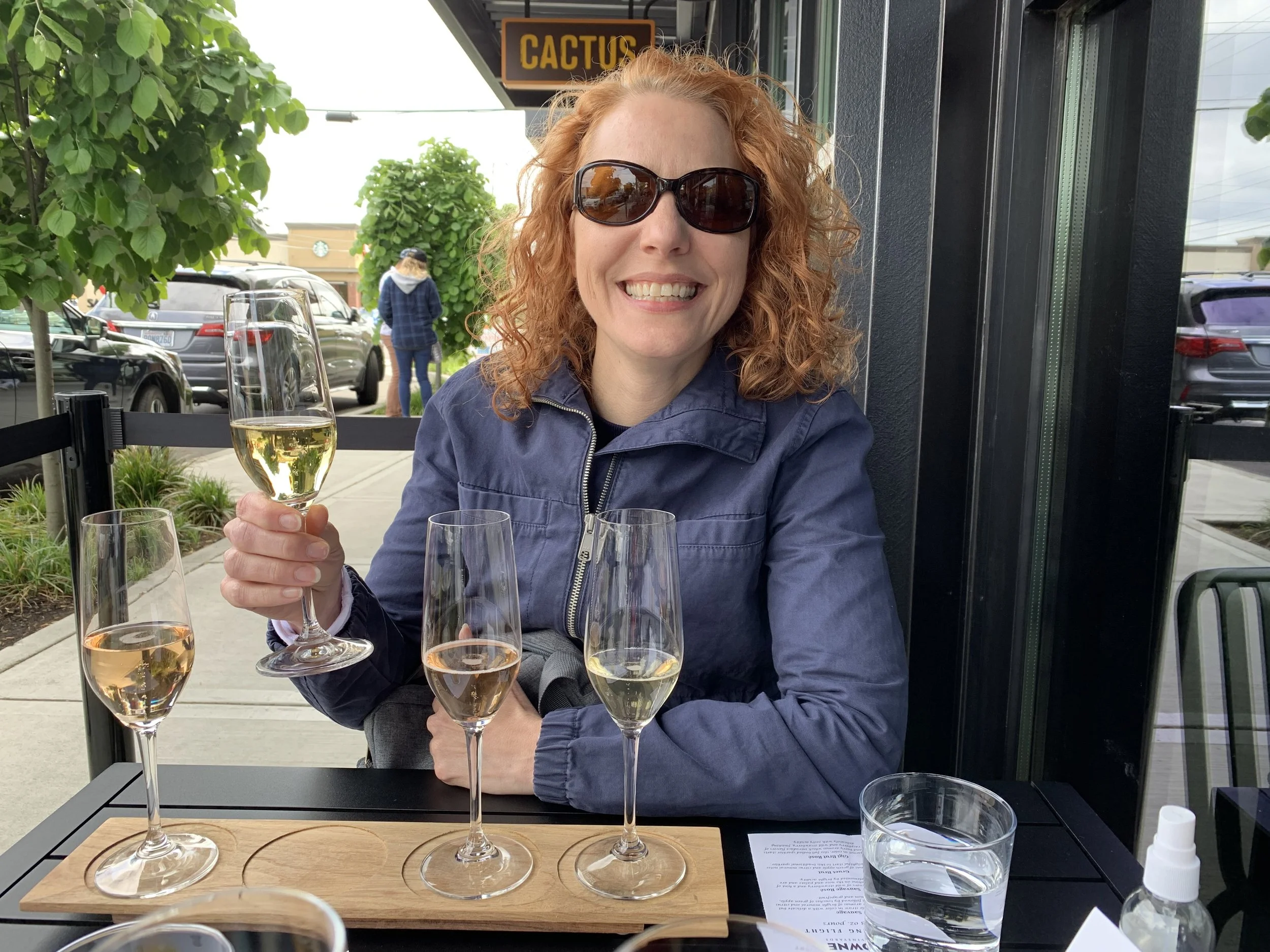S2E5: A shady way to use your skills for good!
/Welcome to Season 2, Episode 5, A Shady Way to Use Your Skills for Good. Season 2 has been all about our food system and some ways that alternative food systems can help our communities be more self-sufficient and sustainable while growing local, culturally relevant food. We’ve also discussed lots of ways that you can get involved in these types of projects in your own communities.
For our final episode this season, we interviewed GIS (and all around) superstar Tonya Kauhi. We chatted with her about how she volunteered to help her community with her GIS skills. While on the surface, this episode appears to be pretty GIS focused, it’s also about thinking outside the volunteer box to identify unique projects where you can share your skills to make your community a better place. We talked to Tonya about how she volunteered her GIS expertise to help Hilltop Urban Gardens in Tacoma. She also shared more about other volunteer activities she is involved with.
Tonya Kauhi
Tonya has a BS in Environmental Science from the University of Washington Tacoma and over 20 years of experience with GIS and geospatial analysis. She recently moved from working as the GIS Programs Manager with the Port of Tacoma to becoming a GIS Developer for the City of Tacoma. She also spent many years working with the private consulting group GeoEngineers as the Senior GIS architect, working on a variety of GIS and data analysis projects. When she’s not busy working, she is still out there sharing her love of GIS. Tonya manages the Washington Women in GIS and Technology Group, volunteers to teach GIS and has taught girls to code in an after school program.
Hilltop Urban Gardens
A map from Tonya’s Presentation at the ESRI ConFerence
Hilltop Urban Gardens (HUG) is located in Tacoma, Washington. The gardens are located in the Hilltop neighborhood and their HUG Farm is at South 19th Street and S Ainsworth Avenue. We had hoped to interview someone with Hilltop Urban Gardens, but unfortunately were not able to connect with them. To be honest, we are not sure of HUG’s current status. Unfortunately, their last Facebook post was in October, 2020. However, we still wanted to provide a little more information about their organization. The following information was gleaned from their Facebook page:
HUG was founded in late 2010 by long-time organizer Dean Jackson. Hilltop Urban Gardens is a community-based urban agriculture, justice, and equity organization. Their mission is to develop systems for food sovereignty and create racial and economic justice.
A slide from Tonya’s ESRI Conference presentation
HUG uses an Urban Farm Network to help those most impacted by food insecurity to grow, eat, share and control their food supply. The Urban Farm network consists of a farm owned by HUG, neighbors donating a portion of their yard, and the use of parking strips. HUG builds and manages the gardens, and these garden sites make up an urban farm. In the past, HUG shared the produce through the HUG Grub farm stand. Anyone from the community could come and pick up a bag of HUG produce. They asked that you share something in exchange; that something could be time, treasure or talent. Some of the things that have been exchanged in for HUG produce in the past included work hours at the Farm or at HUG Grub, hosting a HUG garden site, monetary donation, letting neighbors pick blackberries, love for the community, or cooking a nutritious meal for one's family instead of fast food. In 2019, HUG shared over a ton of healthy produce from 12 Urban Farm Network Sites, they served 18 households weekly, engaged over 300 volunteers and held 64 community and service events. Check in with HUG through Messenger for current programs, hours or volunteer opportunities.
Using Shady Skills for Good - Performing a GIS Sun/Shade Analysis for the Hilltop Urban Gardens
Plant a seed, watch it grow
In this episode we learned more about how Tonya Kauhi got involved in volunteering with Hilltop Urban Gardens and how she figured out a way to share her skill sets for good. She helped HUG identify and prioritize garden growing areas, based on the hours of sunlight the yards, parking strips and gardens received each day. She also created maps that shared location information with garden volunteers. If you want to learn more about the ins and outs of a new ESRI solution for sun shade analysis, check out Jen’s write-up on that.
Tonya shared how her own involvement in her neighborhood community garden is where she first became more interested in community gardens. She originally created simple site maps that showed access, hose bibs, garden beds and plantings and later performed a sun-shade analysis to identify and prioritize areas for planting.
If you aren’t looking on a neighborhood or city-wide level and don’t want to go to the trouble of using GIS software, we found some other resources on the web that may help you determine where the sun shines on your property.
SunCalc doesn’t provide the shade from buildings and vegetation, but does show the course of the sun over the day and the year.
We also found this great permaculture website that helps you plan out how to determine sun/shade on your property.
Sun Surveyor and Sun Seeker are apps that use your phone's GPS and compass to display an accurate representation of the sun’s path through the sky at your location.
How do Hilltop Urban Gardens and Food Sovereignty Tie Together?
Being able to grow food in your own community, especially when there is a lack of access to land, is a great way to help develop community and help minimize the environmental impacts of industrialized agriculture. Hilltop Urban Gardens is a great example of food sovereignty. It puts growing, harvesting, and processing fresh produce in the hands of underrepresented residents in this urban area. It keeps decisions about what food to grow locally. It helps build community through gardening. Tonya found a way to contribute her skills, first through the development of simple maps and later with the sun/shade analysis to identify best places to garden from the properties that they had access to.
Other Ways to Be Cool
In addition to talking about her volunteer work with Hilltop Urban Gardens, Tonya also talked about other ways she volunteers in her community and shares her love for nerding out…er, um, I mean GIS and technology. And I think one of the most important messages in this episode is finding ways to share your skills to make your community better.
Tonya shared how she helped start and currently leads the Washington Women in GIS and Technology group. According to their website, “The Washington Women in GIS and Technology (WWGT) group empowers women to learn, teach, and promote GIS and technology.” They host monthly meetings to network, learn and be social.
She also talked about volunteering with Girls Who Code, where she participated in an after school program that taught girls how to code. She even said she was no coding expert at the time, but was able to get the girls excited and engaged.
Tonya has also helped teach elementary aged students about GIS. She tells a story about talking to the teacher to try and find a way to connect GIS to what they were currently learning about. Since GIS is very diverse, this typically does not present much of an issue, but in this case the students happened to be studying sound. At first she was a little perplexed, but then found that the National Park Service has a Sound Map Project and that there are noise level monitoring apps that could be used in the classroom and on the playground, so students could collect their own data. She was able to add value to what the students were already learning about and teach them about GIS at the same time. Just another WIN = WIN for Superstar Tonya!
All these examples are just to show the variety of ways that Tonya has found to use her skills and knowledge to improve her community, while sharing her love and knowledge of GIS. Hopefully, these ideas will inspire you to find a new and different way to share your skills and knowledge to improve your community.
Until Next Time…
Thank you so much for joining us this season! We hope you learned more about our food system, food sovereignty, and food insecurity, and how these things impact our communities and our environment. We think the biggest take away from this episode is that we all have skills that can help make our communities better, we just need to identify where to plug in. That makes the last episode of this season a crossover between GIS and community involvement. We believe that all people deserve access to healthy, culturally relevant foods and we hope that some of the ideas shared this season will help us all move towards that goal.
We’ll be taking a short break and in a couple of months we will return with Season 3, which will include 4 episodes about the Sustainability in Prisons Project based in Washington State.
Please don’t forget to rate, review and subscribe on Apple Podcasts, Stitcher, or wherever you get your podcasts (like Tune In, Castbox, Himalaya, iheartradio, etc). Please let us know what you think in the comments below or on our Facebook page.
We have had a great time and can’t wait to be back next season.
Until then, Will We Make It Out Alive?









